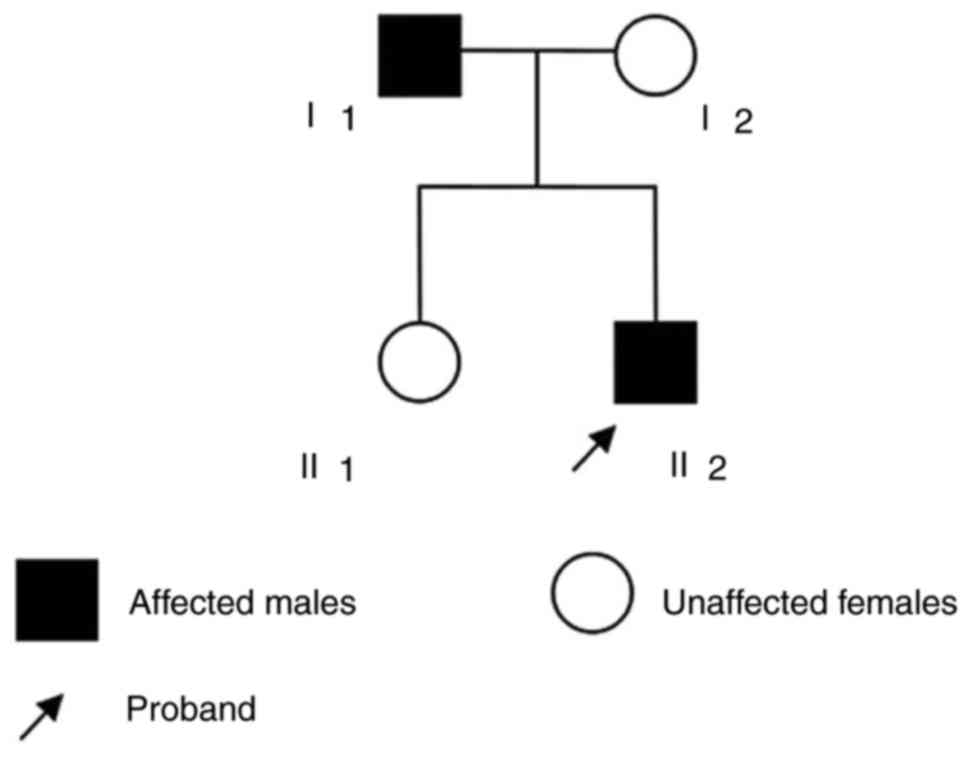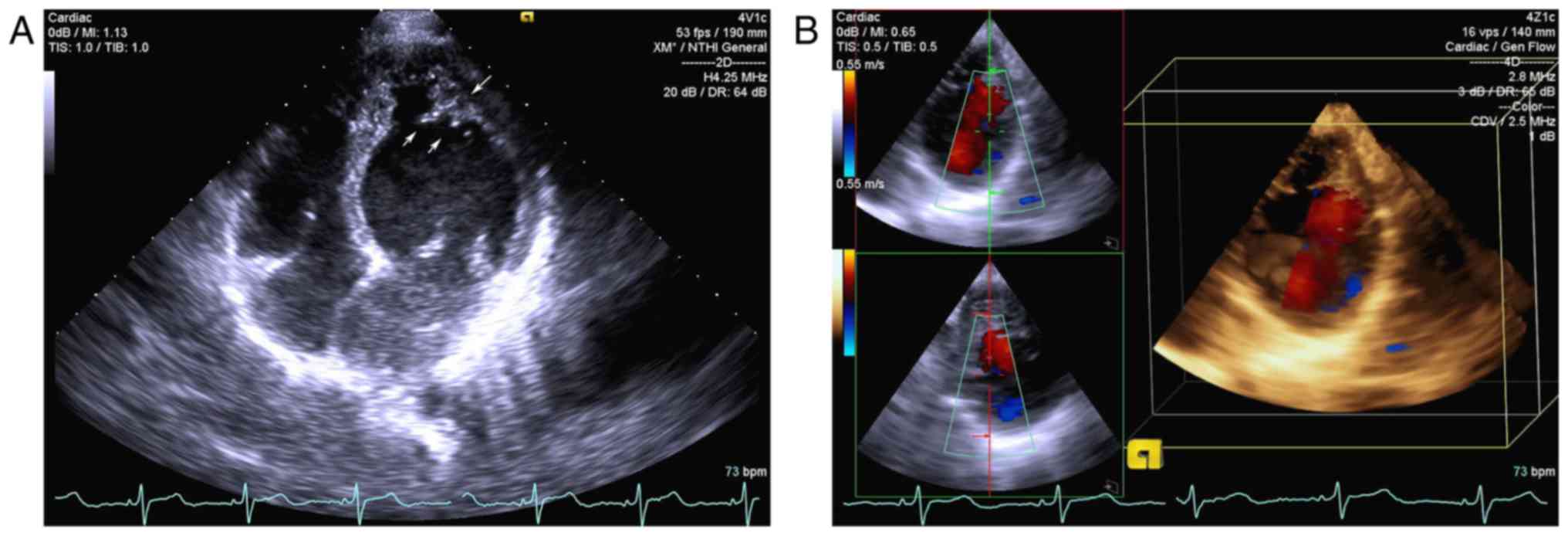|
1
|
Sarma RJ, Chana A and Elkayam U: Left
ventricular noncompaction. Prog Cardiovasc Dis. 52:264–273. 2010.
View Article : Google Scholar : PubMed/NCBI
|
|
2
|
Cheng TO: Left ventricular noncompaction
cardiomyopathy: Three decades of progress. Int J Cardiol.
174:227–229. 2014. View Article : Google Scholar : PubMed/NCBI
|
|
3
|
Ronderos R, Avegliano G, Borelli E,
Kuschnir P, Castro F, Sanchez G, Perea G, Corneli M, Zanier MM,
Andres S, et al: Estimation of prevalence of the left ventricular
noncompaction among adults. Am J Cardiol. 118:901–905. 2016.
View Article : Google Scholar : PubMed/NCBI
|
|
4
|
Ritter M, Oechslin E, Sütsch G, Attenhofer
C, Schneider J and Jenni R: Isolated noncompaction of the
myocardium in adults. Mayo Clin Proc. 72:pp. 26–31. 1997;
View Article : Google Scholar : PubMed/NCBI
|
|
5
|
Ozkutlu S, Ayabakan C, Celiker A and
Elshershari H: Noncompaction of ventricular myocardium: A study of
twelve patients. J Am Soc Echocardiogr. 15:1523–1528. 2002.
View Article : Google Scholar : PubMed/NCBI
|
|
6
|
Stollberger C, Blazek G, Winkler-Dworak M
and Finsterer J: Sex differences in left ventricular noncompaction
in patients with and without neuromuscular disorders. Rev Esp
Cardiol. 61:130–136. 2008.(In Spanish). View Article : Google Scholar : PubMed/NCBI
|
|
7
|
Oechslin EN, Attenhofer Jost CH, Rojas JR,
Kaufmann PA and Jenni R: Long-term follow-up of 34 adults with
isolated left ventricular noncompaction: A distinct cardiomyopathy
with poor prognosis. J Am Coll Cardiol. 36:493–500. 2000.
View Article : Google Scholar : PubMed/NCBI
|
|
8
|
Stollberger C, Blazek G, Wegner C and
Finsterer J: Neurological comorbidity affects prognosis in left
ventricular hypertrabeculation/noncompaction. Heart Lung.
41:594–598. 2012. View Article : Google Scholar : PubMed/NCBI
|
|
9
|
Peters F, Khandheria BK, Botha F, Libhaber
E, Matioda H, Dos Santos C, Govender S, Meel R and Essop MR:
Clinical outcomes in patients with isolated left ventricular
noncompaction and heart failure. J Card Fail. 20:709–715. 2014.
View Article : Google Scholar : PubMed/NCBI
|
|
10
|
Paterick TE, Umland MM, Jan MF, Ammar KA,
Kramer C, Khandheria BK, Seward JB and Tajik AJ: Left ventricular
noncompaction: A 25-year odyssey. J Am Soc Echocardiogr.
25:363–375. 2012. View Article : Google Scholar : PubMed/NCBI
|
|
11
|
Yang J, Zhu M, Wang Y, Hou X, Wu H, Wang
D, Shen H, Hu Z and Zou J: Whole-exome sequencing identify a new
mutation of MYH7 in a Chinese family with left ventricular
noncompaction. Gene. 558:138–142. 2015. View Article : Google Scholar : PubMed/NCBI
|
|
12
|
Zaragoza MV, Arbustini E and Narula J:
Noncompaction of the left ventricle: Primary cardiomyopathy with an
elusive genetic etiology. Curr Opin Pediatr. 19:619–627. 2007.
View Article : Google Scholar : PubMed/NCBI
|
|
13
|
Klaassen S, Probst S, Oechslin E, Gerull
B, Krings G, Schuler P, Greutmann M, Hurlimann D, Yegitbasi M, Pons
L, et al: Mutations in sarcomere protein genes in left ventricular
noncompaction. Circulation. 117:2893–2901. 2008. View Article : Google Scholar : PubMed/NCBI
|
|
14
|
Luxán G, Casanova JC, Martinez-Poveda B,
Prados B, D'Amato G, MacGrogan D, Gonzalez-Rajal A, Dobarro D,
Torroja C, Martinez F, et al: Mutations in the NOTCH pathway
regulator MIB1 cause left ventricular noncompaction cardiomyopathy.
Nat Med. 19:193–201. 2013. View Article : Google Scholar : PubMed/NCBI
|
|
15
|
Finsterer J: Cardiogenetics,
neurogenetics, and pathogenetics of left ventricular
hypertrabeculation/noncompaction. Pediatr Cardiol. 30:659–681.
2009. View Article : Google Scholar : PubMed/NCBI
|
|
16
|
Jenni R, Oechslin E, Schneider J,
Attenhofer Jost C and Kaufmann PA: Echocardiographic and
pathoanatomical characteristics of isolated left ventricular
non-compaction: A step towards classification as a distinct
cardiomyopathy. Heart. 86:666–671. 2001. View Article : Google Scholar : PubMed/NCBI
|
|
17
|
Tian T, Liu Y, Gao L, Wang J, Sun K, Zou
Y, Wang L, Zhang L, Li Y, Xiao Y, Song L and Zhou X: Isolated left
ventricular noncompaction: Clinical profile and prognosis in 106
adult patients. Heart Vessels. 29:645–652. 2014. View Article : Google Scholar : PubMed/NCBI
|
|
18
|
Li H and Durbin R: Fast and accurate
long-read alignment with Burrows-Wheeler transform. Bioinformatics.
26:589–595. 2010. View Article : Google Scholar : PubMed/NCBI
|
|
19
|
DePristo MA, Banks E, Poplin R, Garimella
KV, Maguire JR, Hartl C, Philippakis AA, del Angel G, Rivas MA,
Hanna M, et al: A framework for variation discovery and genotyping
using next-generation DNA sequencing data. Nat Genet. 43:491–498.
2011. View
Article : Google Scholar : PubMed/NCBI
|
|
20
|
Thorvaldsdottir H, Robinson JT and Mesirov
JP: Integrative Genomics Viewer (IGV): High-performance genomics
data visualization and exploration. Brief Bioinform. 14:178–192.
2013. View Article : Google Scholar : PubMed/NCBI
|
|
21
|
Wu J, Li Y and Jiang R: Integrating
multiple genomic data to predict disease-causing nonsynonymous
single nucleotide variants in exome sequencing studies. PLoS Genet.
10:e10042372014. View Article : Google Scholar : PubMed/NCBI
|
|
22
|
R Core Team: R: A language and environment
for statistical computingR Foundation for Statistical Computing.
Vienna: 2014
|
|
23
|
Lee SJ: Genetic analysis of the role of
proteolysis in the activation of latent myostatin. PLoS One.
3:e16282008. View Article : Google Scholar : PubMed/NCBI
|
|
24
|
Bayley CP, Ruiz Nivia HD, Dajani R, Jowitt
TA, Collins RF, Rada H, Bird LE and Baldock C: Diversity between
mammalian tolloid proteinases: Oligomerisation and non-catalytic
domains influence activity and specificity. Sci Rep. 6:214562016.
View Article : Google Scholar : PubMed/NCBI
|
|
25
|
Clark TG, Conway SJ, Scott IC, Labosky PA,
Winnier G, Bundy J, Hogan BL and Greenspan DS: The mammalian
Tolloid-like 1 gene, Tll1, is necessary for normal septation and
positioning of the heart. Development. 126:2631–2642.
1999.PubMed/NCBI
|
|
26
|
Sieron AL and Stanczak P: ASD-lessons on
genetic background from transgenic mice with inactive gene encoding
metalloprotease, Tolloid-like 1 (TLL1). Med Sci Monit.
12:RA17–RA22. 2006.PubMed/NCBI
|
|
27
|
Stanczak P, Witecka J, Szydlo A,
Gutmajster E, Lisik M, Augusciak-Duma A, Tarnowski M, Czekaj T,
Czekaj H and Sieron AL: Mutations in mammalian tolloid-like 1 gene
detected in adult patients with ASD. Eur J Hum Genet. 17:344–351.
2009. View Article : Google Scholar : PubMed/NCBI
|
|
28
|
Scott IC, Blitz IL, Pappano WN, Imamura Y,
Clark TG, Steiglitz BM, Thomas CL, Maas SA, Takahara K, Cho KW and
Greenspan DS: Mammalian BMP-1/Tolloid-related metalloproteinases,
including novel family member mammalian Tolloid-like 2, have
differential enzymatic activities and distributions of expression
relevant to patterning and skeletogenesis. Dev Biol. 213:283–300.
1999. View Article : Google Scholar : PubMed/NCBI
|
|
29
|
Stirewalt DL and Radich JP: The role of
FLT3 in haematopoietic malignancies. Nat Rev Cancer. 3:650–665.
2003. View Article : Google Scholar : PubMed/NCBI
|
|
30
|
Garg M, Nagata Y, Kanojia D, Mayakonda A,
Yoshida K, Keloth SH, Zang ZJ, Okuno Y, Shiraishi Y, Chiba K, et
al: Profiling of somatic mutations in acute myeloid leukemia with
FLT3-ITD at diagnosis and relapse. Blood. 126:2491–2501. 2015.
View Article : Google Scholar : PubMed/NCBI
|
|
31
|
Pfister O, Lorenz V, Oikonomopoulos A, Xu
L, Häuselmann SP, Mbah C, Kaufmann BA, Liao R, Wodnar-Filipowicz A
and Kuster GM: FLT3 activation improves post-myocardial infarction
remodeling involving a cytoprotective effect on cardiomyocytes. J
Am Coll Cardiol. 63:1011–1019. 2014. View Article : Google Scholar : PubMed/NCBI
|
|
32
|
Omer WH, Narita A, Hosomichi K, Mitsunaga
S, Hayashi Y, Yamashita A, Krasniqi A, Iwasaki Y, Kimura M and
Inoue I: Genome-wide linkage and exome analyses identify variants
of HMCN1 for splenic epidermoid cyst. BMC Med Genet. 15:1152014.
View Article : Google Scholar : PubMed/NCBI
|
|
33
|
Chowdhury A, Herzog C, Hasselbach L,
Khouzani HL, Zhang J, Hammerschmidt M, Rudat C, Kispert A, Gaestel
M, Menon MB, et al: Expression of fibulin-6 in failing hearts and
its role for cardiac fibroblast migration. Cardiovasc Res.
103:509–520. 2014. View Article : Google Scholar : PubMed/NCBI
|
|
34
|
Kodo K, Ong SG, Jahanbani F, Termglinchan
V, Hirono K, InanlooRahatloo K, Ebert AD, Shukla P, Abilez OJ,
Churko JM, et al: iPSC-derived cardiomyocytes reveal abnormal TGF-β
signalling in left ventricular non-compaction cardiomyopathy. Nat
Cell Biol. 18:1031–1042. 2016. View Article : Google Scholar : PubMed/NCBI
|
|
35
|
Calvo SE, Tucker EJ, Compton AG, Kirby DM,
Crawford G, Burtt NP, Rivas M, Guiducci C, Bruno DL, Goldberger OA,
et al: High-throughput, pooled sequencing identifies mutations in
NUBPL and FOXRED1 in human complex I deficiency. Nat Genet.
42:851–858. 2010. View
Article : Google Scholar : PubMed/NCBI
|
|
36
|
Loeffen J, Elpeleg O, Smeitink J, Smeets
R, Stockler-Ipsiroglu S, Mandel H, Sengers R, Trijbels F and van
den Heuvel L: Mutations in the complex I NDUFS2 gene of patients
with cardiomyopathy and encephalomyopathy. Ann Neurol. 49:195–201.
2001. View Article : Google Scholar : PubMed/NCBI
|
|
37
|
Benit P, Beugnot R, Chretien D, Giurgea I,
De Lonlay-Debeney P, Issartel JP, Corral-Debrinski M, Kerscher S,
Rustin P, Rötig A and Munnich A: Mutant NDUFV2 subunit of
mitochondrial complex I causes early onset hypertrophic
cardiomyopathy and encephalopathy. Human Mutat. 21:582–586. 2003.
View Article : Google Scholar
|
|
38
|
Park SH, Lee JH, Lee GB, Byun HJ, Kim BR,
Park CY, Kim HB and Rho SB: PDCD6 additively cooperates with
anti-cancer drugs through activation of NF-κB pathways. Cell
Signal. 24:726–733. 2012. View Article : Google Scholar : PubMed/NCBI
|
|
39
|
He YQ, Zhou B, Shi SQ, Zhang L and Li WM:
Genetic variation in PDCD6 and susceptibility to lung cancer. Asian
Pac J Cancer Prev. 13:4689–4693. 2012. View Article : Google Scholar : PubMed/NCBI
|
|
40
|
Zhang K, Zhou B, Shi S, Song Y and Zhang
L: Variations in the PDCD6 gene are associated with increased
uterine leiomyoma risk in the Chinese. Genet Test Mol Biomarkers.
17:524–528. 2013. View Article : Google Scholar : PubMed/NCBI
|
|
41
|
Zhou B, Zhang P, Tang T, Zhang K, Wang Y,
Song Y, Liao H and Zhang L: Prognostic value of PDCD6 polymorphisms
and the susceptibility to bladder cancer. Tumour Biol.
35:7547–7554. 2014. View Article : Google Scholar : PubMed/NCBI
|
|
42
|
Zhou B, Bai P, Xue H, Zhang Z, Shi S,
Zhang K, Wang Y, Wang K, Quan Y, Song Y and Zhang L: Single
nucleotide polymorphisms in PDCD6 gene are associated with the
development of cervical squamous cell carcinoma. Fam Cancer.
14:1–8. 2015. View Article : Google Scholar : PubMed/NCBI
|
|
43
|
Rho SB, Song YJ, Lim MC, Lee SH, Kim BR
and Park SY: Programmed cell death 6 (PDCD6) inhibits angiogenesis
through PI3K/mTOR/p70S6K pathway by interacting of VEGFR-2. Cell
Signal. 24:131–139. 2012. View Article : Google Scholar : PubMed/NCBI
|
















